by Jennifer Bearden | Feb 23, 2015
 Many plants and animals have been introduced to new regions for centuries, as people have discovered new lands. These transient species are known as non-natives, and can become invasive. Invasive species occur throughout the world and may blend in, be nondescript or highly attractive; they can be plant or animal; terrestrial or aquatic; they may resemble or remind the viewer of something familiar; they may be very good at adapting to our climate and conditions which is how many invasive species get their foothold in an area. And because they have not evolved alongside our native species, when introduced to areas lacking their natural predators, they can adapt and take off.
Many plants and animals have been introduced to new regions for centuries, as people have discovered new lands. These transient species are known as non-natives, and can become invasive. Invasive species occur throughout the world and may blend in, be nondescript or highly attractive; they can be plant or animal; terrestrial or aquatic; they may resemble or remind the viewer of something familiar; they may be very good at adapting to our climate and conditions which is how many invasive species get their foothold in an area. And because they have not evolved alongside our native species, when introduced to areas lacking their natural predators, they can adapt and take off.
Conditions in the SE US are ripe for many invasive contenders. Some species have been intentionally introduced and other species have been accidentally introduced. Some common invasive species include red imported fire ants, Kudzu, Privet, Chinese tallow, Japanese climbing fern, Chinaberry, and cogongrass, just to name a few on the tip of the iceberg. These species are now out-of-control, and it is unlikely they will ever be eradicated from their new home.
In 2011 alone, the Department of the Interior spent more than $100 million on invasive species prevention, early detection and rapid response, control and management, research, outreach, international cooperation and habitat restoration in the US. (USFWS) This is a drop in the bucket when you consider in FY 1999-2000, nine Florida agencies spent $90.8 million on prevention, monitoring, control, and restoration efforts. It is estimated that the annual cost of invasive plants, animals and diseases in losses to Florida’s agriculture is estimated at $179 million annually (www.defenders.org).
Much like a cancer can spread in the body, so too, when conditions are favorable can invasive species spread across the landscape. Once established in the landscape eradication is expensive; ideally early monitoring is critical to understanding its movement and dispersal, coverage, and containment. Like cancers, early detection provides better opportunity to address the situation. Within the landscape, an aggressive invasive can impact the entire ecosystem – causing a serious imbalance; followed by a cascade of impact via unforeseen collateral damage.
Take the newest aquatic threat of Lionfish. The trophic impacts of lionfish could alter the structure of native reef fish communities and potentially hamper stock rebuilding efforts of the Snapper –Grouper Complex. Additional effects of the lionfish invasion are far-reaching and could increase coral reef ecosystem stress, threaten human health, and ultimately impact the marine aquarium industry. Control strategies for lionfish are needed to mitigate impacts.
Disturbances like new roads, land clearing, and tropical weather events (hurricanes) can all provide the opportunity for invasive species to get a foothold. So, the next time you notice a plant or animal that you don’t recognize, take a picture and report it using the “I’ve Got One!” phone app or on-line to The Early Detection & Distribution Mapping System (EDDMapS.org). You can also report to the nearest Extension Agent.
A good way to learn how to identify and control some of our common invasives is to join a volunteer workday at a park near you sponsored by the Six Rivers Cooperative Invasive Species Management Area (CISMA) or the Florida Native Plant Society.
GUEST AUTHOR: Barbara Albrecht, Director of Panhandle Watershed Alliance, member is the Six Rivers Cooperative Invasive Species Management Area.
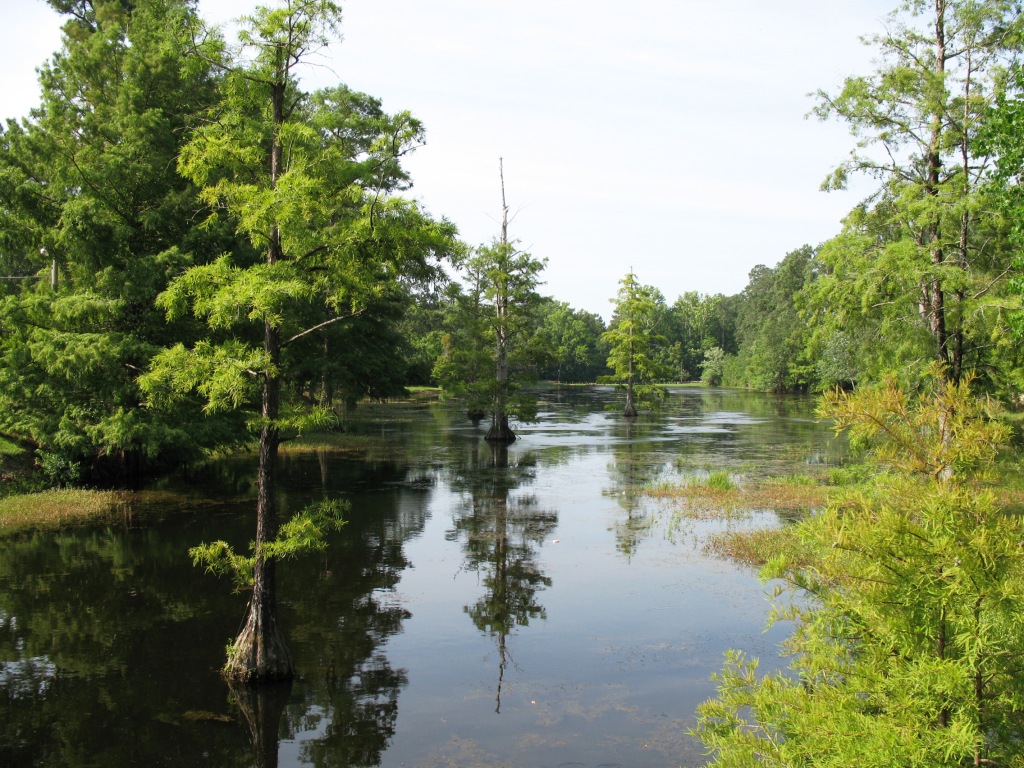
by Rick O'Connor | Feb 20, 2015
The Everglades Cooperative Invasive Species Management Area (ECISMA) is organizing a nonnative freshwater fishing tournament for Invasive Species Week.
Begins: 6:00 AM Saturday February 21, 2015
Ends: 12:00 AM Sunday March 1, 2015
OBJECTIVES FOR TOURNAMENT
- Document the distribution of freshwater nonnative fish in Florida
- Increase awareness of the problem with nonnative freshwater fish
- Encourage anglers to target nonnative species
RULES FOR TOURNAMENT
- All anglers must register on EDDMaps – this is easy… visit http://eddmaps.org/
- When recording on EDDMaps all data must complete with exact location (GPS preferred) and include a photo. Photos should have fish flat on a light colored background, in shade if possible, head facing left, and extend the fins as much as possible.
- The boundaries for the tournament are all legally fished freshwater bodies of water in Florida
- All fish must be caught within compliance with the State of Florida regulations. Visit MyFWC.com/fishing/freshwater/regulations or visit a local bait and tackle shop for these.
- Native species are not eligible
PRIZES FOR TOURNAMENT
Most Unusual Catch – Adult
- First Prize – $75 gift certificate to Bass Pro Shop and Lionfish Be the Predator T-shirt
- Second Prize – $50 gift certificate to Bass Pro Shop and Lionfish Be the Predator T-shirt
- Third Prize – $25 gift certificate to Bass Pro Shop and Lionfish Be the Predator T-shirt
Most Species – Adult
- First Prize – $75 gift certificate to Bass Pro Shop and Lionfish Be the Predator T-shirt
- Second Prize – $50 gift certificate to Bass Pro Shop and Lionfish Be the Predator T-shirt
- Third Prize – $25 gift certificate to Bass Pro Shop and Lionfish Be the Predator T-shirt
Most Unusual Catch – Youth
- First Prize – $50 gift certificate to Bass Pro Shop and Lionfish Be the Predator T-shirt
- Second Prize – $25 gift certificate to Bass Pro Shop and Lionfish Be the Predator T-shirt
- Third Prize – $15 gift certificate to Bass Pro Shop and Lionfish Be the Predator T-shirt
Most Species – Youth
- First Prize – $50 gift certificate to Bass Pro Shop and Lionfish Be the Predator T-shirt
- Second Prize – $25 gift certificate to Bass Pro Shop and Lionfish Be the Predator T-shirt
- Third Prize – $15 gift certificate to Bass Pro Shop and Lionfish Be the Predator T-shirt
For a list of nonnative targets you can visit EDDMaps.com, MyFWC.com, or contact your local county Extension office. We encourage all participants to take and eat what you catch.
DISCLAIMER
It is expressly understood that participants in the 2015 Nonnative Fish Catch, Click, and Submit enter at their own risk and that Everglades CISMA and all participating organizations, Officers, Event Sponsors, and Committees, and all other persons connected directly or indirectly with the operation of said event, shall be exempt from any liability for liable, slander, loss, damage, negligence, harm, injury, or death suffered by any participant, entrant, vessel, and equipment, companions, and guests, boat captains, mates, or crew members, which may occur in conjunction with the 2015 Nonnative Fish Catch, Click, and Submit.
For more information contact ECISMA at http://evergladescisma.org/.
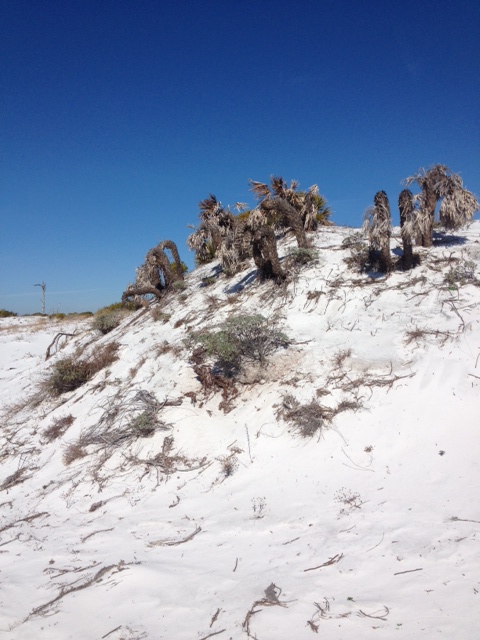
by Rick O'Connor | Feb 20, 2015
Making the Big Sabine hike on Santa Rosa Island in February was COLD! A front had pasted over the day before and temp was in the 30’s with a north wind. But the sky was a beautiful blue and the Gulf was calm and clear.

The Gulf is smooth and clear most winter mornings.
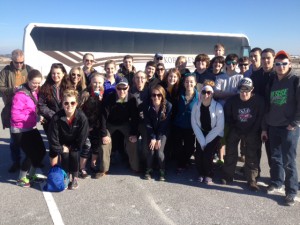
Wildlands Environmental High School from Wisconsin making a dune hike on a cold Florida morning.
Joining me on my hike this month was the Wildlands School from Wisconsin. They were visiting the Gulf Coast working on a variety of projects and wanted to learn more about coastal ecology… so I brought them along. Because of the drop in temperature we did not see much wildlife. In January I saw very little other than birds. In February we saw few birds… it was really cold. As we hiked from the Gulf to the Sound we discussed barrier island and dune formation and showed many of the plants common in the different dune fields we mentioned in our January issue. Most were brown in color but there were a few evergreens and we even had one secondary bush blooming! Beach Heather (Conradina canescens).
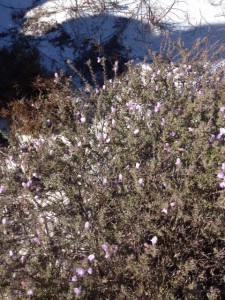
Beach heather (Conradina canescens) blooming early in the year on a cold morning.
We did see a few mammal tracks and had a chance to discuss “animal sign” with the students, but no live animals were seen. The kids from Wisconsin were introduced to cactus (literally… many had it on their shoes) as we walked through the maritime forest and I had a chance to explain the xeric conditions found on our barrier islands and how this favored particular plants and animals. While in the maritime forest we also came across an old aquaculture facility and this gave me a chance to discuss this industry as well. But for me the most interesting discovery in the maritime forest was a “drag-line” that I had found in January near one of the ponds. As we walked past this area again – it was there again and seemed to be “fresh” (recently made). I am not sure what makes these drag marks – have a few guesses – but am hoping to discover the source before the end of this series.
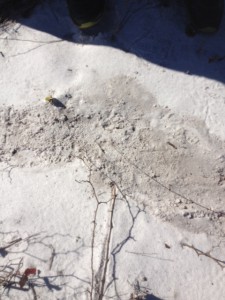
Strange drag marks we have seen each month so far. They are found near one of the ponds on the Sound side.
Despite the north wind the Sound was calm and clear. Most of the marine creatures had moved into deeper-warmer waters but we did find a dead cannonball jellyfish. The students from Wisconsin got a chance to hold the slimy creature and we discussed how the stinging cells (nematocyst) work. These small cells on the tentacles of jellyfish have a triggering mechanism that is actually discharged by the object that touches it… the jellyfish does not do this. Once the trigger is moved a dart with a drop of venom is discharged into whatever triggered it. Several of these firing at once is what causes the pain we feel, or the death of a small fish. They were also excited to discover a primitive camp site that locals use. I explained the correct protocol for doing this and hope that locals do the same.
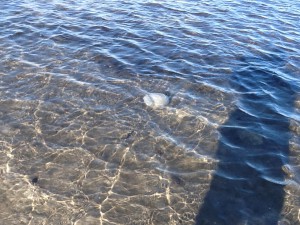
I found this along the shore last winter. These are cannonball jellyfish.
Though there was not a lot of wildlife to view in February but the beach is absolutely beautiful this time of year. The sunrises and sunsets are amazing. I encourage local “panhandlers” to visit your local island and take a long walk. I think you will enjoy it.
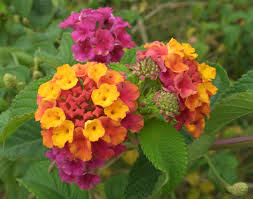
by Sheila Dunning | Feb 20, 2015
It’s Growing So Well It Must Be A Good Plant. Right?

Lantana camera
You know that plant in the corner of the yard that seems to be taking over? It’s the one that your friend “passed along” because they had plenty of them and wanted to share. After all, it grows so well. How can you go wrong? The odds are that vigorous plant is a non-native species. The majority of what is sold in nurseries are introduced from a foreign country and developed for their uniqueness.
The problem is that many of the plants brought into the United States arrive without their natural enemies. Under the long, warm growing season found in Florida, these non-native plants become the dominant plant in an area and manage to out-compete the native plants. When this happens, these introduced plants get labeled as an “invasive species”.
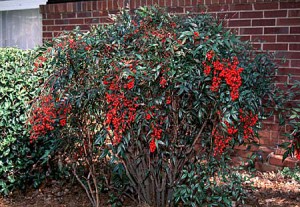
Nandina domestica
If you want to learn more about your friend’s ”passalong” plant be sure to visit the Assessment of Nonnative Plants in Florida’s Natural Areas website and database at http://assessment.ifas.ufl.edu/.

Ruellia brittoniana Mexican Petunia
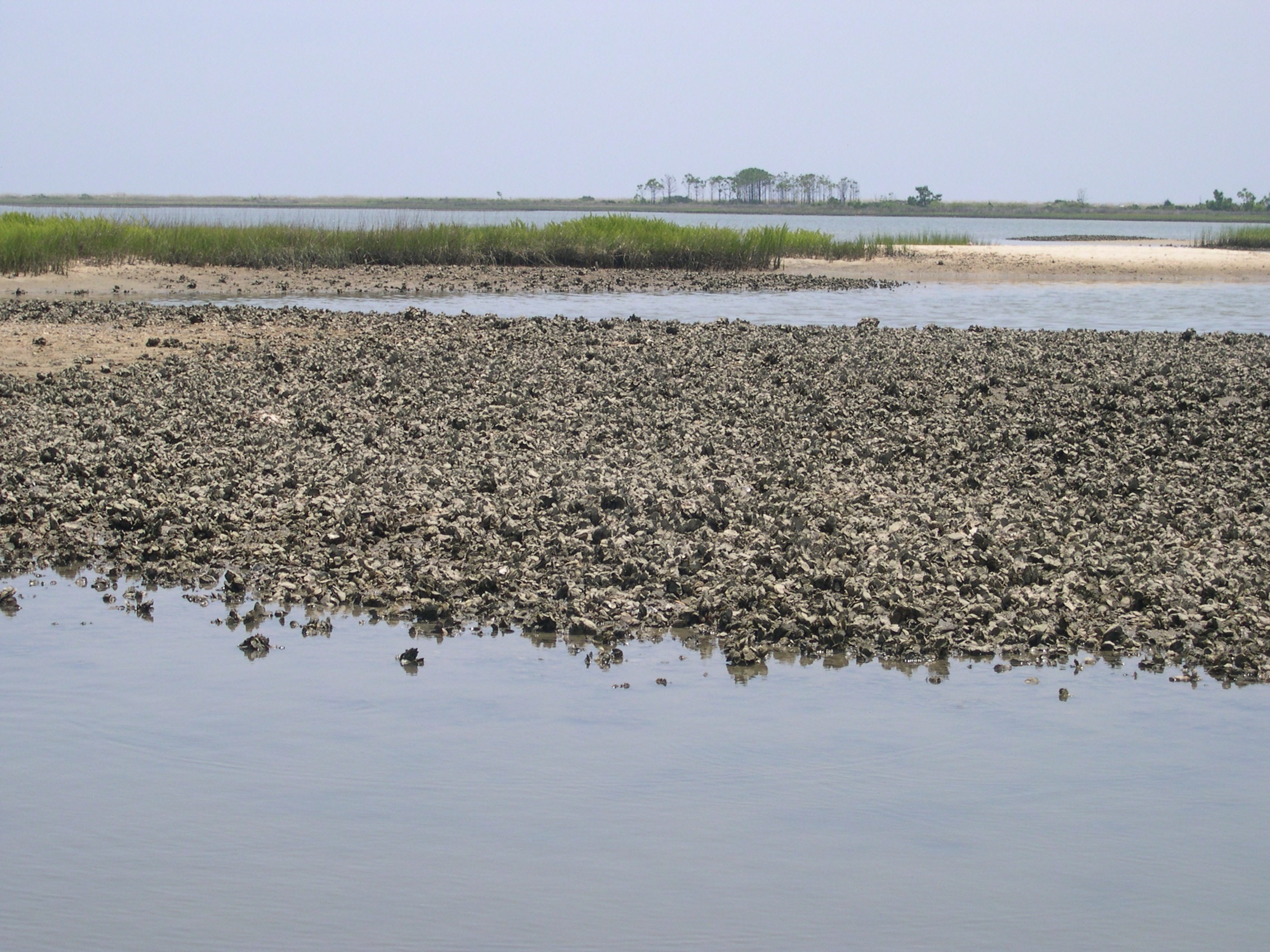
by Erik Lovestrand | Feb 6, 2015
Nature has provided us with an incredible resource in the diverse assemblage of molluscan shellfish that inhabit our coastal bays and estuaries. One bivalve species in particular provides many human benefits. The eastern oyster (Crassostrea virginica) has not only proven to be a preferred food species for people but also derives many vital ecosystem services through its existence in our near-shore estuaries. Oysters are born as planktonic larvae that drift in the water for about 2 weeks. They are called a spat when they settle out of the water column and glue themselves to a suitable hard surface, such as another oyster shell, and begin to grow their own shell. Oysters feed on particulates in the water throughout their life and when mature can filter as much as 50 gallons per day. Because of this life style they provide some degree of water purification and improvement in water clarity. The structure of an oyster reef is also a valuable habitat component which provides shelter for a plethora of small creatures that support a vast food web in the estuary ecosystem.
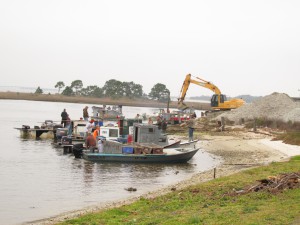
Oystermen participate in shelling program for Apalachicola Bay
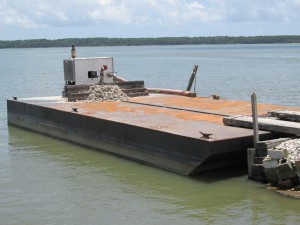
Barges will also be used to relay shells for replenishing oyster habitat.
Although we have several native species of oysters in the Gulf of Mexico the eastern oyster is the only species that supports a commercial industry. in Florida, the bulk of that industry has traditionally been centered around Apalachicola Bay in the mid-Panhandle region of the state. This one estuary system typically produces 90 percent of the state’s oyster crop and 10-13 percent of the nation’s harvest. Some good harvest years have yielded 4-6 million pounds of oyster meat (shells excluded) from this single bay. In recent years however there has been a dramatic decline in oyster abundance. The industry, along with concerned natural resource managers, is seeking to rebuild numbers to a sustainable harvest level. The reasons for this precipitous drop in numbers is the subject of much debate but savvy natural resource professionals believe a combination of factors have been involved over several years to cause the current situation.
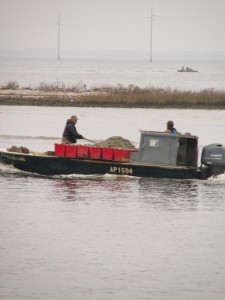
Fossil oyster shell being relayed to bay bottom.
So, how do you bring back a thriving oyster industry from the brink of collapse? Several factors need to be considered and addressed as part of a holistic management approach. At the present time there are two primary mechanisms being employed to support increased oyster recruitment to Apalachicola Bay. The first involves “planting” a suitable material on the bay bottom for oyster spat attachment and growth. In the past this has primarily consisted of oyster shells from the shucking plants. More recently the industry has been employing the use of fossil shell material from a local mine. Oystermen are being employed to transfer the shell from land-based loading areas to the designated deposition sites in the bay. Funding is also forthcoming to allow shelling by barges to cover more area. The other strategy to assist with recovery has involved the use of regulatory authority in consultation with local experts and oystermen with decades of experience on the bay. This approach can reduce the harvest pressure on oysters and support a more rapid recovery, given proper conditions in the estuary. Bag limits have been reduced, enforcement has been stepped up to ensure compliance with the rules, and harvest areas have been adjusted.
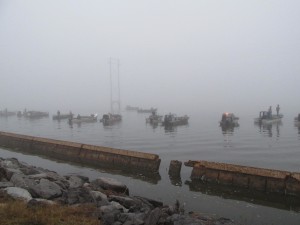
Oystermen line up early to receive shell for relay project.
There are, of course, other important aspects to the solution for bringing back the thriving industry of the past and many of them relate to natural cycles of drought and flooding. Increasing human demands for water from the river system that feeds the bay tend to magnify the effects of natural drought cycles. If salinity remains high for longer periods there is an increased pressure from oyster predators that typically are limited by lower salinity. Factors related to oyster diseases and parasites are also in the mix. To say that it is a complicated situation would be an understatement. Researchers who have studied the system for their entire careers find it difficult to quantify the problems and solutions for this large, complex natural ecosystem that has been an important cultural and economic component of Florida’s makeup since early humans roasted or cracked open the first oyster. Hopefully, with enough concerned partners working towards effective management strategies we can once again enjoy in abundance the wholesome, delicate morsels that have been called the food of the gods.
Article by: Erik Lovestrand
Franklin County Extension Director
Sea Grant Regional Agent II
 Many plants and animals have been introduced to new regions for centuries, as people have discovered new lands. These transient species are known as non-natives, and can become invasive. Invasive species occur throughout the world and may blend in, be nondescript or highly attractive; they can be plant or animal; terrestrial or aquatic; they may resemble or remind the viewer of something familiar; they may be very good at adapting to our climate and conditions which is how many invasive species get their foothold in an area. And because they have not evolved alongside our native species, when introduced to areas lacking their natural predators, they can adapt and take off.
Many plants and animals have been introduced to new regions for centuries, as people have discovered new lands. These transient species are known as non-natives, and can become invasive. Invasive species occur throughout the world and may blend in, be nondescript or highly attractive; they can be plant or animal; terrestrial or aquatic; they may resemble or remind the viewer of something familiar; they may be very good at adapting to our climate and conditions which is how many invasive species get their foothold in an area. And because they have not evolved alongside our native species, when introduced to areas lacking their natural predators, they can adapt and take off.














